So we’re now in mid Spring. The weather is warming up, and sunny days are with us for a few weeks at least. Flowers are springing up in the garden and everything starting to look glorious.
What do you want to eat for dinner? You don’t just want salad, salad, salad. You don’t want anything too heavy. Why not look to the Italians for ideas?
 Pasta is incredibly versatile in its various forms. We all know a lasagne can be meaty or made with vegetables, and served with a salad is a great Spring and Summer main dinner meal.
Pasta is incredibly versatile in its various forms. We all know a lasagne can be meaty or made with vegetables, and served with a salad is a great Spring and Summer main dinner meal.
Pasta can make a lovely salad dish – a tomato-based cold pasta salad, simple cooked pasta and pesto, a pasta cheese salad; there are numerous options.
One dinner dish I love is a creamy chicken and mushroom tagliatelle – you can of course adjust to taste by swapping chicken for more mushrooms or paneer, swap the tagliatelle for linguini, spaghetti, penne or other pasta, leave out the wine, use a different stock. But the basic recipe is the same.
I use my own home-made chicken stock (frozen in ice cubes) but do use any stock cubes or fresh stock you prefer.
Ingredients:
- Chicken breasts (one per person) sliced into strips
- Generous handful of halved or quartered mushrooms
- Small onion, chopped fairly finely
- 2-3 cloves of garlic, minced or finely chopped
- 1 teaspoon cornflour
- Glass of dry white wine
- Approx. 100ml chicken stock
- 375ml double cream
- Pinch of Rosemary (or other preferred herbs)
- Pinch of nutmeg
- Salt and pepper
Method:
 Fry the chicken in a little oil until golden but not fully cooked. Remove from the pan and set aside.
Fry the chicken in a little oil until golden but not fully cooked. Remove from the pan and set aside.
In the same pan, cook the onions and mushrooms in a little oil, for a couple of minutes with some salt and pepper. Add the garlic.
Stir in the cornflour, then the wine. Stir the pan well, scraping all the browned bits until the pan is clear (deglazing the pan).
 Return the chicken to the pan (with any juices released by resting), and add the chicken stock then the cream and stir while bringing to the boil. Once boiling, add the rosemary and nutmeg and turn the heat down to a simmer while you cook the pasta. Taste your sauce and add any more seasoning you like.
Return the chicken to the pan (with any juices released by resting), and add the chicken stock then the cream and stir while bringing to the boil. Once boiling, add the rosemary and nutmeg and turn the heat down to a simmer while you cook the pasta. Taste your sauce and add any more seasoning you like.
Once all cooked, spoon the pasta into the sauce – never sauce to pasta! If you find the sauce has over-thickened, add a little of the pasta water until it reaches the consistency you like.
Serve with some grated Italian hard cheese and lovely buttered crusty bread!

We all know, living in the UK, that weather can be turbulent. Unlike other countries, we can experience all 4 seasons in one day! Our bodies aren’t as used to the heat as others, so be sensible.
Sunscreen and a hat is essential for young children, but also remember your pets. If you have white cats, the hair on their ears can be very thin and cats have been known to get skin cancer. Using a dab of sun block can help (no they won’t like you doing it!). Ensure there’s easily-accessible fresh water daily for them to drink. If you serve your pets wet food, remove any uneaten food or it will very quickly get slimy and begin to smell – and attract pests. If you go out and leave your pets – eg to go to work, do ensure they have shade to shelter under as well as water available. Consider closing curtains if a room is particularly sunny.
have been known to get skin cancer. Using a dab of sun block can help (no they won’t like you doing it!). Ensure there’s easily-accessible fresh water daily for them to drink. If you serve your pets wet food, remove any uneaten food or it will very quickly get slimy and begin to smell – and attract pests. If you go out and leave your pets – eg to go to work, do ensure they have shade to shelter under as well as water available. Consider closing curtains if a room is particularly sunny.
 Dogs might love lying in the sun, but do bear in mind how hot it gets and the type of dog you have. Generally, they will be OK if under 25°c, but the flat-faced breeds such as Pugs, overweight dogs, elderly dogs or those with health conditions, all may not fare as well in the heat as they appear to. Look out for over-panting and if too hot to go for a walk, it really won’t harm them to miss out. Never, ever, leave a dog in a car on a hot day! Not even to nip into a shop. A car heats up very quickly and is significantly hotter inside than outside.
Dogs might love lying in the sun, but do bear in mind how hot it gets and the type of dog you have. Generally, they will be OK if under 25°c, but the flat-faced breeds such as Pugs, overweight dogs, elderly dogs or those with health conditions, all may not fare as well in the heat as they appear to. Look out for over-panting and if too hot to go for a walk, it really won’t harm them to miss out. Never, ever, leave a dog in a car on a hot day! Not even to nip into a shop. A car heats up very quickly and is significantly hotter inside than outside.
Well that’s enough nagging from me. Let’s all enjoy the sunshine now while we have it. Go for picnics, enjoy eating out in the garden. Let the kids, and animals, splash in a pool. It will be wet and cold again before we know it!
For picnic ideas, or having a gathering, my book ‘Picnics, Parties and Drinks’ is available on Amazon for just £2.99. https://tinyurl.com/ym2v7eb3
love
Maggie x



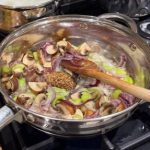
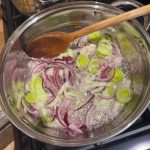 In a pan, add some vegetable oil and the red onions, and begin frying them. After a couple of minutes add the leek and mushrooms. Give this a stir and allow them to fry a little before stirring in the mustard, sugar, honey and balsamic.
In a pan, add some vegetable oil and the red onions, and begin frying them. After a couple of minutes add the leek and mushrooms. Give this a stir and allow them to fry a little before stirring in the mustard, sugar, honey and balsamic.





 Roasting meat joints have become so ridiculously expensive – and you don’t want the more affordable chicken every single Sunday. When we eat out, I tend to go for a beef roast as, whilst expensive, it’s not all that much more these days than buying the joint and vegetables and cooking it myself. We rarely have lamb because the price has risen so much – just for the two of us a small leg of lamb would be over £12. But I really fancied it for today.
Roasting meat joints have become so ridiculously expensive – and you don’t want the more affordable chicken every single Sunday. When we eat out, I tend to go for a beef roast as, whilst expensive, it’s not all that much more these days than buying the joint and vegetables and cooking it myself. We rarely have lamb because the price has risen so much – just for the two of us a small leg of lamb would be over £12. But I really fancied it for today.



 Mealtimes should never be a battle. It’s simply a stressful lose:lose situation. Young children, toddlers in particular, can be the most stubborn little brick walls. Parents understandably want the child to eat, but, unless there’s medical reasons that the child absolutely must eat, it’s not going to hurt them to miss a meal if they refuse. They’ll come back when they’re hungry.
Mealtimes should never be a battle. It’s simply a stressful lose:lose situation. Young children, toddlers in particular, can be the most stubborn little brick walls. Parents understandably want the child to eat, but, unless there’s medical reasons that the child absolutely must eat, it’s not going to hurt them to miss a meal if they refuse. They’ll come back when they’re hungry. One of my children had the exact same lunch every single day of primary school – a completely plain ham sandwich – nothing added, not even butter on the bread! Goodness knows what the school thought of me, but it meant he ate. As a baby and toddler he just hated chewing. Everything had to be soft and sloppy – he pretty much lived off fromage frais for a year! I’d already had 2 children before him and learned the hard way what trying to force a toddler to eat results in – plenty of bolognaise stains on the carpet to prove it. So, I had a much more relaxed attitude the 3rd time round. And guess what, none of the children ended up under-nourished or under-fed. As an adult, the child in question will now try absolutely any food and is probably the most adventurous eater of the 3.
One of my children had the exact same lunch every single day of primary school – a completely plain ham sandwich – nothing added, not even butter on the bread! Goodness knows what the school thought of me, but it meant he ate. As a baby and toddler he just hated chewing. Everything had to be soft and sloppy – he pretty much lived off fromage frais for a year! I’d already had 2 children before him and learned the hard way what trying to force a toddler to eat results in – plenty of bolognaise stains on the carpet to prove it. So, I had a much more relaxed attitude the 3rd time round. And guess what, none of the children ended up under-nourished or under-fed. As an adult, the child in question will now try absolutely any food and is probably the most adventurous eater of the 3.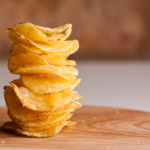 Home made crisps
Home made crisps






 Avocado and Strawberry Salad
Avocado and Strawberry Salad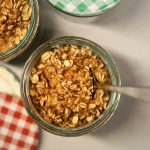
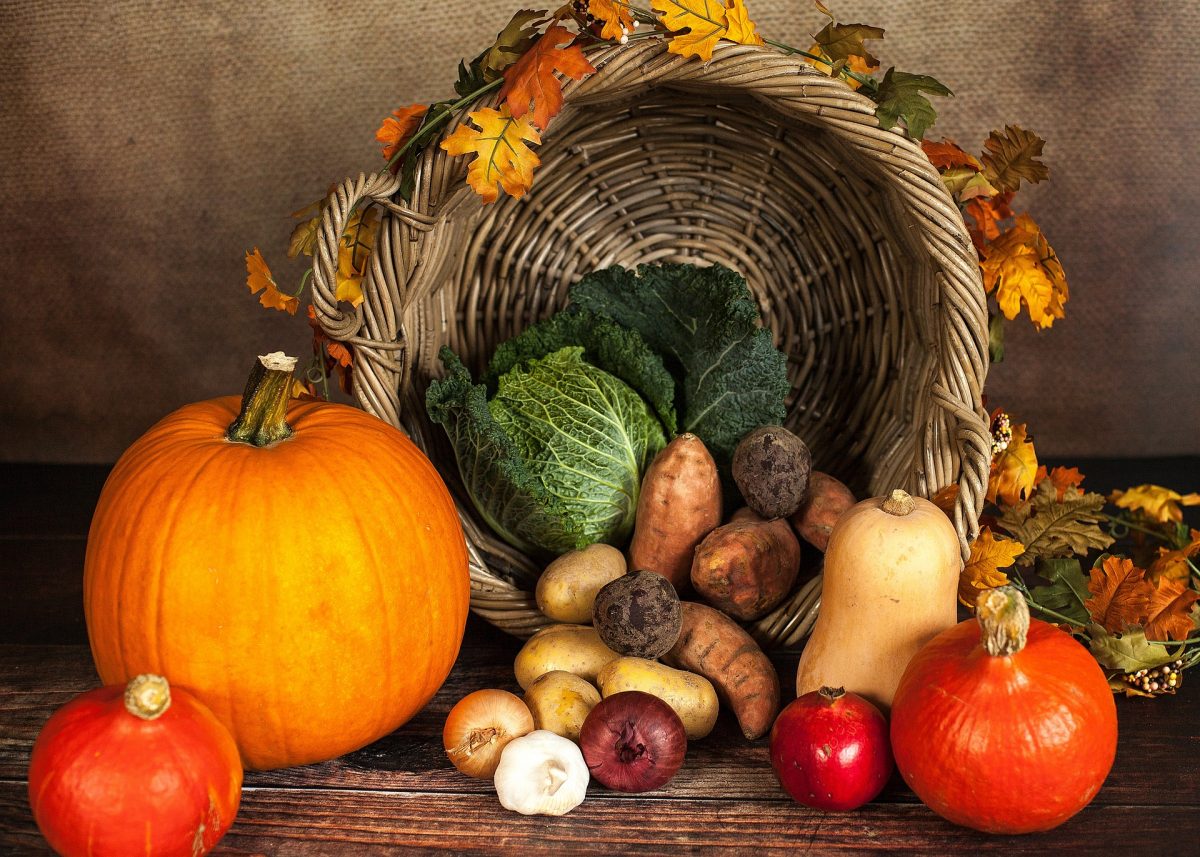

 So, the sun’s out in the UK and the daily summer temperatures have been confirmed as the highest since records began. It’s the perfect excuse to eat as many ice lollies and as much ice cream as you can get away with.
So, the sun’s out in the UK and the daily summer temperatures have been confirmed as the highest since records began. It’s the perfect excuse to eat as many ice lollies and as much ice cream as you can get away with.



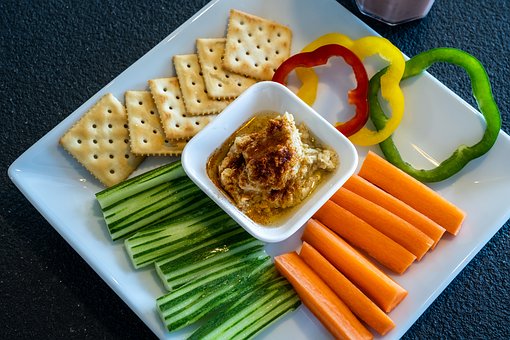
 Slice up some fingers of vegetables such as carrots, peppers, cucumber, celery, mange tout, mini sweetcorn. Ideal on their own, you can add a healthy dip such as hummus or peanut butter if you like. For an element of sweetness, slice up a nice crunchy apple, some blueberries, raisins, Brazil nuts and sunflower seeds. Again, if you need a dip some natural yoghurt would be a nice addition.
Slice up some fingers of vegetables such as carrots, peppers, cucumber, celery, mange tout, mini sweetcorn. Ideal on their own, you can add a healthy dip such as hummus or peanut butter if you like. For an element of sweetness, slice up a nice crunchy apple, some blueberries, raisins, Brazil nuts and sunflower seeds. Again, if you need a dip some natural yoghurt would be a nice addition. A lot of our eating timescales are habitual. As a species, humans like consistency and habits form easily. Try to avoid insisting on a set time for your coffee or tea break, or at least don’t always take a slice of cake or sugary biscuit at the same time. These should be occasional treats, not a daily habit. If you can mix up your break times, you won’t find you feel hungry shortly before this time as a matter of habit.
A lot of our eating timescales are habitual. As a species, humans like consistency and habits form easily. Try to avoid insisting on a set time for your coffee or tea break, or at least don’t always take a slice of cake or sugary biscuit at the same time. These should be occasional treats, not a daily habit. If you can mix up your break times, you won’t find you feel hungry shortly before this time as a matter of habit. Nuts: Mixed nuts are a brilliant source of protein and healthy fats, but you may want to add sultanas or raisins for a top up of sweetness. Avoid salted nuts to avoid excess sodium in your diet.
Nuts: Mixed nuts are a brilliant source of protein and healthy fats, but you may want to add sultanas or raisins for a top up of sweetness. Avoid salted nuts to avoid excess sodium in your diet. Root vegetable crisps: If you’re a crisp fiend, and just can’t let them go, swap potato crisps for vegetable crisps. You can buy them, or make your own (simple recipe available in my book ‘Picnics, Parties and Drinks’).
Root vegetable crisps: If you’re a crisp fiend, and just can’t let them go, swap potato crisps for vegetable crisps. You can buy them, or make your own (simple recipe available in my book ‘Picnics, Parties and Drinks’). Roasted chickpeas: drain and rinse a tin of chickpeas, then dry them as much as possible. Place in a bowl and drizzle with oil, then sprinkle with salt and any herbs you may want to add for flavour. With your hands, mix together to ensure all the chickpeas are coated then spread them out evenly onto a dry baking tray. Roast the chickpeas at 400F/200C for 20-30 minutes, stirring or shaking the chickpeas every 10 minutes to ensure even roasting. Don’t worry if any chickpeas pop or split. Once golden in colour remove from the oven and, while still warm, sprinkle spices if you want (eg chilli or paprika) and stir through. When warm these are crispy, but when cool they become more chewy.
Roasted chickpeas: drain and rinse a tin of chickpeas, then dry them as much as possible. Place in a bowl and drizzle with oil, then sprinkle with salt and any herbs you may want to add for flavour. With your hands, mix together to ensure all the chickpeas are coated then spread them out evenly onto a dry baking tray. Roast the chickpeas at 400F/200C for 20-30 minutes, stirring or shaking the chickpeas every 10 minutes to ensure even roasting. Don’t worry if any chickpeas pop or split. Once golden in colour remove from the oven and, while still warm, sprinkle spices if you want (eg chilli or paprika) and stir through. When warm these are crispy, but when cool they become more chewy.
 Sugar is a prime culprit. You get a short-term mood lift, but sugar causes an imbalance in chemicals in your brain. These chemical imbalances can lead to depression or cause mood swings and raise feelings of anxiety. On top, excess consumption of sugar can of course cause obesity and tooth decay – in themselves these cause you to dislike your own appearance and can even result in quite serious clinical depression.
Sugar is a prime culprit. You get a short-term mood lift, but sugar causes an imbalance in chemicals in your brain. These chemical imbalances can lead to depression or cause mood swings and raise feelings of anxiety. On top, excess consumption of sugar can of course cause obesity and tooth decay – in themselves these cause you to dislike your own appearance and can even result in quite serious clinical depression. If you’re a fish eater, eat more Omega 3 rich fish such as sardines, trout, salmon and mackerel. For non-fish eaters, other foods high in Omega 3 include walnuts, chia seeds, soybean oil, plus foods specifically fortified with Omega 3 (this will be declared on the food packaging). Dietary supplements are also available.
If you’re a fish eater, eat more Omega 3 rich fish such as sardines, trout, salmon and mackerel. For non-fish eaters, other foods high in Omega 3 include walnuts, chia seeds, soybean oil, plus foods specifically fortified with Omega 3 (this will be declared on the food packaging). Dietary supplements are also available. To avoid blood sugar drops, eat regularly but also choose slow-release energy foods such as rice, pasta, wholegrain breads, cereals, nuts and seeds. Avoid sugary food and drink, to avoid blood sugar fluctuations.
To avoid blood sugar drops, eat regularly but also choose slow-release energy foods such as rice, pasta, wholegrain breads, cereals, nuts and seeds. Avoid sugary food and drink, to avoid blood sugar fluctuations.
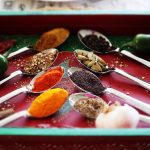 I recommend keeping a basic stock of spices to hand ready. A little pestle and mortar means you can create your own curry powder/paste for your own signature dish. A simple spice mix would be equal quantities of brown sugar, cinnamon, cloves, nigella seeds, turmeric, cumin, coriander, cardamom and garam masala. Grind any non-powdered spice (eg cumin seeds) to a powder with a pestle and mortar, and mix all the powders together. When using your home-made curry powder, you can add heat by including fresh chopped chillies, or dried chilli powder. You can use a tinned tomato base or a creamy one with coconut milk. Ensure you cook the spices for a minute or two in oil to release the aromas, but don’t allow them to burn before you add in your chosen liquid.
I recommend keeping a basic stock of spices to hand ready. A little pestle and mortar means you can create your own curry powder/paste for your own signature dish. A simple spice mix would be equal quantities of brown sugar, cinnamon, cloves, nigella seeds, turmeric, cumin, coriander, cardamom and garam masala. Grind any non-powdered spice (eg cumin seeds) to a powder with a pestle and mortar, and mix all the powders together. When using your home-made curry powder, you can add heat by including fresh chopped chillies, or dried chilli powder. You can use a tinned tomato base or a creamy one with coconut milk. Ensure you cook the spices for a minute or two in oil to release the aromas, but don’t allow them to burn before you add in your chosen liquid.